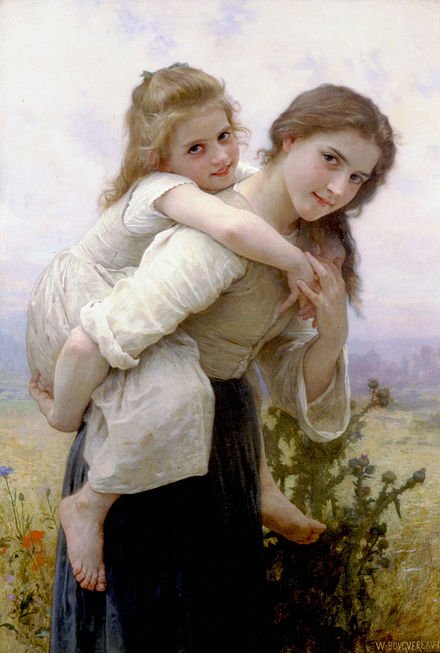William Bougereau
William-Adolphe Bouguereau was a 19th-century French painter who specialized in academic art, a style characterized by realistic, highly detailed depictions of human figures.
Known for his masterful use of color and light, and the ability to capture the beauty and grace of his subjects, he often painted young women and children.
Highly sought after by collectors and patrons of the arts, he was considered one of the most successful and renowned artists of his time.
Today, Bouguereau's works can be found in museums and private collections around the world.
William-Adolphe Bouguereau was the most influential upholder of the conservative values of French academic art in his day.
His paintings stress those values: precise drawing, contour, and finish, along with strict adherence to the rules of anatomy, perspective, academic modeling, and physiognomic expression in which internal character is revealed by outward appearance. An heir of Jacques-Louis David and Jean-Auguste-Dominique Ingres, Bouguereau's subjects included Classical, mythological, allegorical, or Orientalist themes, as well as contemporary history. Most of his works were popularly known through engravings.
From 1843 to 1850, Bouguereau studied at the École des Beaux-Arts, winning the Prix de Rome in 1850. When he returned from Rome, Bouguereau decorated several great houses, drawing his inspiration from the frescoes at Pompeii and Herculaneum. He was awarded a medal of honor at the Paris exhibition of 1878 and in the 1885 Salon.
Bouguereau's academic renderings were highly regarded by many of his contemporaries, but they were exactly what the Impressionists rebelled against. When Pierre-Auguste Renoir was being fitted with new glasses to correct his myopia, he threw the spectacles on the floor, crying: Bon Dieu, je vois comme Bouguereau! ("Good God, I see like Bouguereau!")
. His works were sought after, often selling quickly and sometimes even before they were completed.
Within the academic art community, Bouguereau was considered one of the greatest painters of his time.
His art embodied a sense of taste, refinement, and respect for tradition. He commanded high prices for his works, and international collectors were known to acquire his paintings. Bouguereau's success was largely uninterrupted throughout his career.
However, Bouguereau faced criticism and disdain from the avant-garde, who viewed him as a competent technician trapped in the past. The term "Bouguereauté" was coined by Edgar Degas and his associates to describe any artistic style that relied on what they considered "slick and artificial surfaces," also referred to as a "licked finish." Degas, known for his wit and association with the Impressionists, wrote a letter in 1872 claiming to strive for Bouguereau's working style, though it's possible the statement was intended ironically.
Paul Gauguin, another prominent artist of the time, held a strong dislike for Bouguereau and gave him a scathing review in his writings. Gauguin rated Bouguereau a "round zero" in his book Racontars de Rapin and recounted an incident when he encountered Bouguereau's paintings in a brothel in Arles, stating that they belonged there.
In 1926, American art historian Frank Jewett Mather criticized the commercial intent of Bouguereau's work, writing that the artist "multiplied vague, pink effigies of nymphs, occasionally draped them, when they became saints and madonnas, painted on the great scale that dominates an exhibition, and has had his reward.
I am convinced that the nude of Bouguereau was prearranged to meet the ideals of a New York stockbroker of the black walnut generation." Bouguereau confessed in 1891 that the direction of his mature work was largely a response to the marketplace: "What do you expect, you have to follow public taste, and the public only buys what it likes. That's why, with time, I changed my way of painting."
Bouguereau fell into disrepute after 1920, due in part to changing tastes.
Comparing his work to that of his Realist and Impressionist contemporaries, Ken Clark faulted Bouguereau's painting for lubricity, and characterized such Salon art as superficial, employing the "convention of smoothed-out form and waxen surface."
Prices for Bouguereau's works have climbed steadily since 1975, with major paintings selling at high prices: $1,500,000 in 1998 for The Heart's Awakening, $2,600,000 in 1999 for The Motherland and Charity at auction in May 2000 for $3,500,000.


